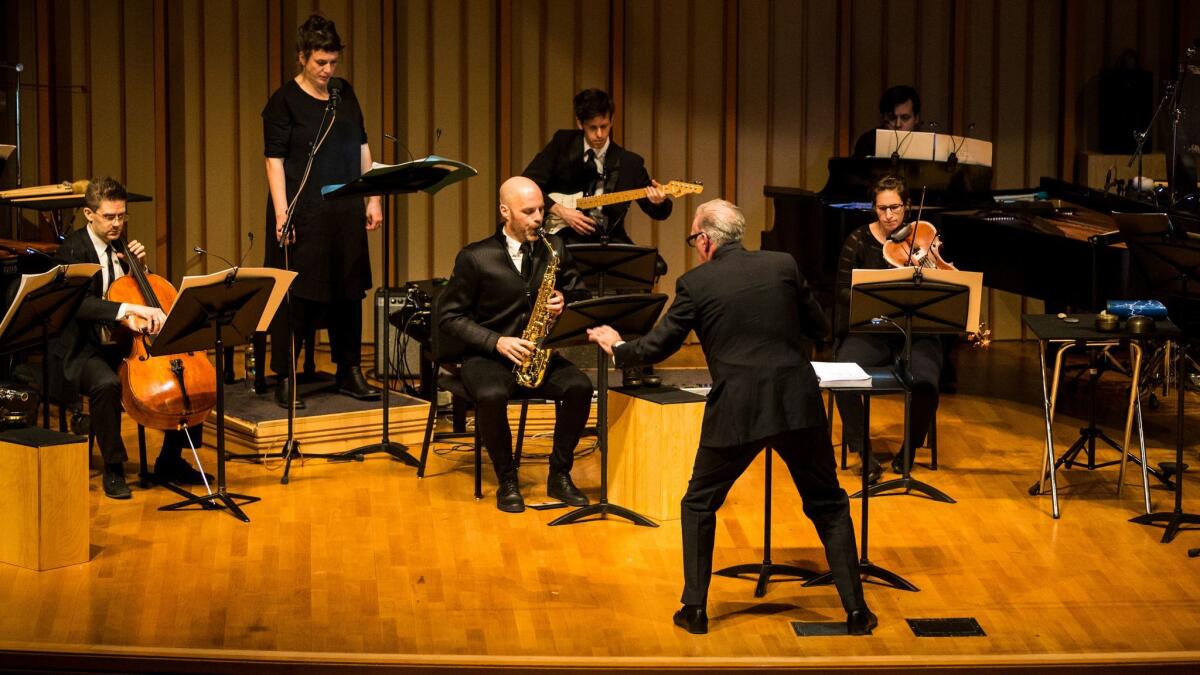Review: A musical saint and her discontents at the Monday Evening Concerts

The first composer in the Western canon whose name we know and whose voice continues to exert considerable contemporary resonance was a woman â the 12th century Benedictine abbess Hildegard of Bingen.
Her music remained unknown for 800 years, but within the last few decades she, her mystical visions, her writings, her correspondence and especially her music have become so celebrated that a plant and a planet have been named after her; she has been the subject of documentaries and a novel; she has spawned new age cults; David Lynch has produced a âTwins Peaksâ-style spooky CD of her music; and she has inspired an avant-garde feminist group of composers who called themselves Hildegurls. Five years ago the music-loving Pope Benedict XVI canonized Hildegard.
Finally, Saint Hildegard (nobody calls her that, though) has reached the Monday Evening Concerts. We think of this as a new music series, but when it was founded in Silver Lake in 1939, the idea was to look at music outside normal concert life, and that meant such locals as Schoenberg and Stravinsky as well as musicians before Bachâs time. Of course, no one back then knew about Hildegard.
Monday night, the series opened its season with some of her rapturous hymns and songs sung with blinding luminosity by five female soloists (accompanied by harp and vielle) from Ensemble Vocatrix, who didnât so much take oneâs breath away as hyper-oxygenate the Colburn Schoolâs Zipper Concert Hall. Hildegard then happened to be intriguingly followed by a recent piece, âFace,â by the avant-garde Italian composer Pierluigi Billone, performed by the superb New York new music ensemble Talea.
Billone took his inspiration from the old Italian word for face, which also meant light and star. That is exactly what Hildegard evokes with her radiant harmonies and ecstatic melodies, so wondrously uninhibited next to more conventionally restrained liturgical chants of the Middle Ages, when she illustrates Godâs glory and radiance of heavenâs glow.
Billone, however, goes several steps further. Over the course of nearly an hour, he systematically depletes atmospheric oxygen. âFaceâ is written for a solo singer, here the heroically fearless Anna Clare Hauf, an âad hocâ musician (who makes ritualistic percussive sounds), a flute that musically stalks the mezzo and an ensemble of 10 other musicians and electronics.
For Billone the voice has become what he calls a âfossil.â He is a composer-archaeologist who explores the remnants of voices past. He is also a mad scientist in the lab. The singer hits her body over and over to find its resonances. She makes every revolting utterance she can to see whatâs under the skin. The ensemble players get in on the masochistic act, hitting themselves as well.
The body, according to Billone, âeventually chews, devours, spits, vomits or builds the word [face] anew.â Thatâs not a bad description of what âFaceâ sounds like. Vision and ritual are turned into emptiness. This is music as ugly as Hildegardâs is beautiful. But it is also, in its perverse way, just as beatific.
If you can get past the sheer sonic grossness of âFace,â it seems meant as its own celebration of sound. Over loudspeakers we hear the voices of John Cage, Karlheinz Stockhausen and Luigi Nono speaking of the liberation of sound as sound. Billone then rubs the listenerâs face in that.
At one extreme, Billone strives for the edge of audibility. Percussionists rub skins with fingers light as feathers, wind players whisper into or on their instruments, string players stroke their instruments as though lovers. At the other extreme come massive explosions, like that of a wailing saxophone or a mezzoâs vocal cords on the verge of bursting. Nothing is hidden.
What to make of âFaceâ? It sounds like the Italian avant-garde of the past 50 years â Luciano Berioâs fabulously sensual applications of extended vocal techniques, Nonoâs use of the voice as a tool for social change, Giacinto Scelsiâs Hildegardian approaches to ecstasy and Salvatore Sciarrinoâs more recent experiments with perception â in the repulsively late stages of decay with nothing but the scraps left to work with. Maybe thatâs necessary to move on. But we were also reminded Monday that Hildegard is forever.
However disagreeable it may have sounded at times, the performance, conducted by James Baker, had all the signs of actually being first rate. The guest percussionist was Jonathan Hepfer, who is now in his third season as artistic director and who has made the venerable Monday Evening Concerts a newly hip DTLA attraction while remaining as musically essential as ever.
MORE MUSIC:
Where to look for treasure in Californiaâs new gold rush? Try John Adamsâ new opera
Pasadena Symphony musicians authorize a strike for higher pay
A steady 25-year-old hand conducts the L.A. Phil and Hilary Hahn
More to Read
The biggest entertainment stories
Get our big stories about Hollywood, film, television, music, arts, culture and more right in your inbox as soon as they publish.
You may occasionally receive promotional content from the Los Angeles Times.











